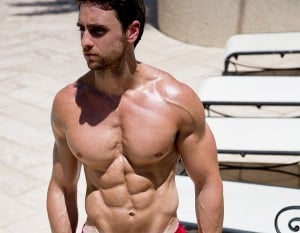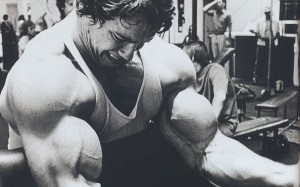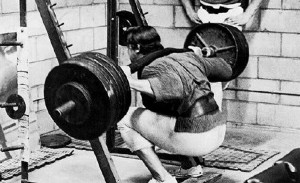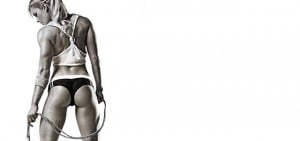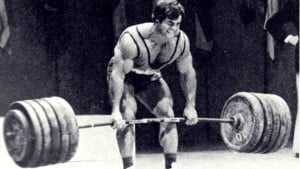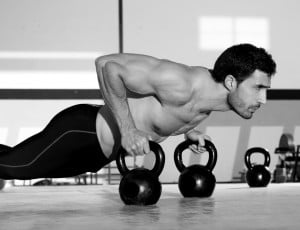“What are the best exercises for building muscle?”
“Should I use heavy or lighter weights?”
“What’s the best rep range?”
“What type of workout split is most effective?”
“How many days per week should I train?”
These are just a few of the questions many people have about building muscle.
Chances are you’re wondering some of the same things.
I’d also be willing to bet that this isn’t the first article you’ve read looking for answers, and that you’re at least slightly baffled and frustrated by the amount of contradictory advice and opinions on the subject.
It makes one wonder if there even is a universal “best” way to build muscle or if it all comes down to genetics, trial and error, and luck.
Well, I have good news for you:
There is a simple science of building muscle.
At bottom, there are diet and training principles that, when applied, work invariably. Some people see faster results than others, but everyone sees results.
And in this article, I want to focus on the training side of that equation. (Go here to learn about the dietary principles.)
By the end of this article, you’re going to know what makes a good muscle building workout and what doesn’t, and how to get the most muscle gain out of your time in the gym.
I have to warn you, though–the truth isn’t sexy.
- It’s simple. Much simpler than you’ve been led to believe.
- It’s devoid of shortcuts. The price must be paid and the process followed.
- It’s hard work. And no matter how much progress you make, it never gets easier.
If you can accept that, then you’re ready to break free of all the nonsense and learn, once and for all, what it really takes to build the body you want.
Let’s get to it.
Table of Contents
How Heavy Should You Train to Build Muscle?
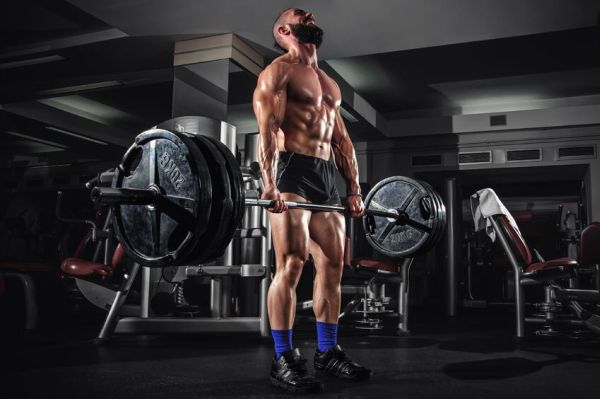
One of the first questions I had when I started lifting was how heavy I should be training.
That is, which rep range is best, and why?
Is the 10 to 12 range espoused by most fitness magazine workouts the way to go? Higher? Lower?
Well, I quickly learned that getting a simple answer to this question is far from simple.
The amount of dissent among experts leaves you scratching your head, wondering whom to believe.
That was years ago, though, and I’ve done a lot of studying since and have worked with a few thousand people, and I feel I have an answer worth sharing.
And the good news is you’ll be able to quickly verify my advice. Put it into use and within 4 to 6 weeks you will know whether it’s working for or not.
To unravel this mystery, let’s begin with a quick review of the physiology of muscle growth.
How to Stimulate Muscle Growth

There are three primary ways to stimulate muscle growth:
1. Progressive tension overload
This refers to progressively increasing tension levels in the muscle fibers.
The most effective way to do this is to progressively increase the amount of weight you’re lifting over time.
2. Muscle damage
This refers to the small tears in muscle fibers that are caused by high levels of tension.
This damage necessitates repair, and if the body is provided with proper nutrition and rest, the muscle fibers will adapt to better deal with similar stimuli in the future (i.e., grow stronger and bigger).
3. Cellular fatigue
This refers to pushing muscle fibers to their metabolic limits through the repetition of actions to muscular failure.
You can think of these three factors as separate muscle growth “pathways,” and they can be emphasized differently in your training.
For example, low-volume, high-weight training emphasizes progressive overload and muscle damage, and high-rep, “pump” training emphasizes cellular fatigue.
Now, out of each of these pathways, progressive tension overload is the most important for building muscle and strength.
This is why your primary goal as a natural weightlifter is to get stronger, and especially on key compound exercises like the squat, deadlift, and bench and overhead press.
Here’s a simple rule of thumb:
The more weight you can push, pull, and squat, the more muscular you’re going to be.
I learned this lesson several years ago.
For my first seven years of weightlifting, I more or less trained exclusively in the 10 to 12 rep range (70 to 75% of one-rep max) and did a lot of traditional (isolation) “bodybuilding” exercises.
I also spent about 10 hours per week in the gym.
Here’s what it got me:
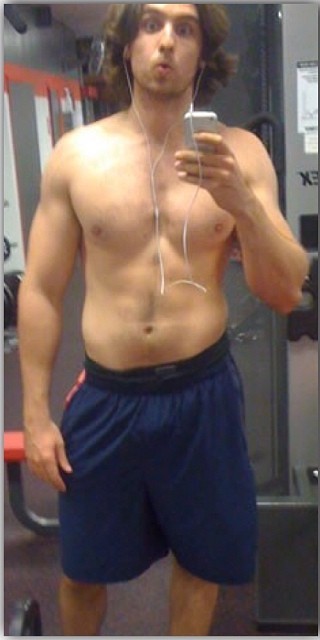
As you can imagine, I wasn’t thrilled. I didn’t look horrible but that’s not exactly what you’d expect for seven years of consistent weightlifting.
Soon after that picture was taken, I dramatically changed my training regimen.
I started focusing on the 4 to 6 rep range (80 to 85% of 1RM) and centered my training around progressing on the big, compound movements.
Here’s a shot of me about 2.5 years later:
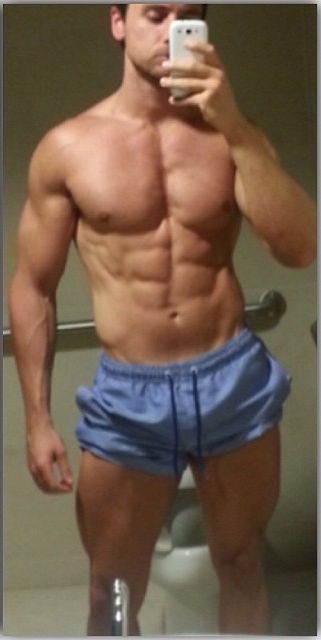
I learned how to diet as well, but as you can see, every aspect of my physique markedly improved.
My strength went through the roof, too. In those 2.5 years, I added close to 100 pounds to my bench and overhead presses and doubled my squat and deadlift.
And better still, I did it in just 4 to 6 hours in the gym each week.
Now, I was baffled by my results because I had thought, like most people, that heavy weightlifting is good for building strength but not muscle.
Well, as you can see, there’s more to that story…
What Is the Best Rep Range for Building Muscle?

This is one of the most important training questions you can ask.
Get it right and you can build the body you want faster than you think.
Get it wrong and you’ll get partway there, plateau, and tread water.
It’s really that simple.
Unfortunately, this is also one of the most controversial training questions you can ask, too.
There are many theories and many opinions, but the progression of scientific and anecdotal evidence is pointing in a clear direction:
If you want to maximize muscle growth, you want to train with heavy loads and a moderate volume.
That is, you want to emphasize heavy weights (80%+ of 1RM) and you want to do a moderate number of reps per major muscle group each week.
For example, one well-designed study published earlier this year separated 33 physically active, resistance-trained men into two groups:
- A high-volume, moderate-intensity group that did 4 workouts per week consisting of 4 sets per exercise in the 10 to 12 rep range (70% of 1RM).
- A moderate-volume, high-intensity group that did 4 workouts per week consisting of 4 sets per exercise in the 3 to 5 rep range (90% of 1RM).
Both groups did the same exercises (which included the bench press, back squat, deadlift, and seated shoulder press), and both were instructed to maintain their normal eating habits (which was monitored with food diaries).
And the result?
After 8 weeks of training, scientists found that the high-intensity group gained significantly more muscle and strength than the high-volume group.
It’s no surprise that the high-intensity group gained more strength, but many people wouldn’t have expected them to gain more muscle as well.
Researchers cite two main reasons for why the heavier training beat out the lighter:
1. Higher amounts of mechanical stress imposed on the muscles.
The high-volume training, on the other hand, caused higher amounts of metabolic stress.
2. Greater activation of muscle fibers.
And this, in turn, results in a greater adaptation across a larger percentage of the muscle tissue.
So, what can we learn from this study (and from others like it)?
1. We should focus on lifting heavy weights for fewer reps.
This is more important than maximizing cellular fatigue through high-rep sets, drop sets, giant sets, and so forth.
2. We should focus on progressive overload.
In the study outlined above, subjects increased weight after hitting their prescribed reps for two workouts.
The key here was an emphasis on increasing weight on the bar, not on increasing the number of reps performed.
3. We should focus on multiple-joint compound exercises.
cough…Bigger Leaner Stronger…cough
Now, that isn’t to say that higher rep training and isolation exercises have no place in a weightlifting program.
They just shouldn’t be the focus.
You can read more about this here.
What Is the Best Training Frequency For Building Muscle?

Many people think that frequency alone is the key to maximizing gains.
To them, it’s black and white: if you’re not training major muscle groups 2 to 3 times per week, you’re not going to get very far.
This makes for good one-liners in YouTube videos, but misses the forest for the trees.
How frequently you can and should train each muscle group depends on the intensity and volume of your individual workouts.
There are many viable ways to lay out workout programs, but there’s also an overarching, non-negotiable rule that ultimately governs results:
The higher the volume and intensity of individual workouts, the less frequently you can do them.
That is, you can only do so much every week before running into issues related to overtraining.
So sure, you can squat or bench press three times per week…but you can’t do 10 heavy sets per workout.
This is why popular powerlifting programs look so austere compared to the nonsense you find in most bodybuilding magazines.
This brings us to the next point:
A well-designed workout program not only emphasizes heavy, compound weightlifting for each major muscle group; it puts you in a “sweet spot” in terms of total weekly volume as well.
How you reach that volume in terms of number of workouts–one, two, three, etc.–is of secondary importance.
What is that sweet spot, though?
Well, there aren’t any studies that give a definitive, one-size-fits-all answer as to how hard and how much you can train to maximize your results, and there many never be.
Optimal volume is modified by intensity, as you know, but there are many other factors that come into play as well including diet, training experience, sleep hygiene, genetics, and more.
That said, there is enough clinical and anecdotal evidence available to derive some sensible guidelines.
Let’s first look at a large and extensive review of weightlifting studies conducted by scientists at Goteborg University.
Their research found that, when using weights in the 60 to 85% of 1RM range, optimal volume appears to be in the range of 30 to 60 reps per major muscle group per workout when 2 to 3 workouts were performed each week.
Thus, a total weekly volume of somewhere between 60 and 180 reps per major muscle group.
As you can guess, the heavier the training, the fewer reps you can and should do every week.
If you were training exclusively in the 80 to 85% of 1RM range, like you do on my Bigger Leaner Stronger program, you’d want to be around 60 to 80 total reps per major muscle group per week.
If you were doing a low-weight, high-volume type of program, however, you’d want your weekly volume for each major muscle group to be closer to 180 reps.
And if you were doing something in between, like with my Thinner Leaner Stronger program for women, your total weekly reps would be somewhere in between as well.
These findings also agree with another large review conducted by researchers at Arizona State University.
When lighter weights are used, more sets per week is optimal. As the weights get heavier, however, total sets must come down.
So, the key takeaway is this:
When it comes to building muscle, training frequency isn’t as important as intensity and total weekly volume.
Think of frequency as a tool that you use to reach your target volume, and there are pros and cons to every type of workout split.
You want to choose the one that best fits your circumstances and needs, and you can learn more about this here.
3 Muscle Building Workouts That Really Work

Cogent arguments and copious PubMed links mean nothing if you can’t use the information to get results.
And that’s why I want to leave you with a few workouts to choose from that will allow you to put my “teachings” to the test.
In terms of overall results, the 5-day program is better than the 4-day, which is better than the 3-day.
The 5-Day Workout Routine
Working sets are done with 85% of 1RM (4 to 6 rep range) unless specified otherwise.
Warm-up by doing 3 to 4 sets of 8 to 10 reps with 50% of 1RM.
Rest 3 to 4 minutes in between working sets.
Rest 1 minute in between warm-up sets.
Add weight once you hit the top of the working set rep range for one set.
DAY 1
CHEST & ABS
Incline Barbell Bench Press – Warm-up sets and then 3 working sets
Incline Dumbbell Bench Press – 3 working sets
Flat Barbell Bench Press – 3 working sets
Face Pull – 3 working sets of 8 to 10 reps per set with 1 to 2 minutes of rest in between these lighter sets
DAY 2
BACK & CALVES
Barbell Deadlift – Warm-up sets and then 3 working sets
Barbell Row – 3 working sets
Wide-Grip Pull-Up or Chin-Up – 3 working sets (weighted if possible)
Optional: Close-Grip Lat Pulldown – 3 working sets
Optional: Barbell Shrugs – 2 working sets
DAY 3
SHOULDERS & ABS
Seated or Standing Barbell Military Press – Warm-up sets and then 3 working sets
Side Lateral Raise – 3 working sets
Bent-Over Rear Delt Raise – 3 working sets
DAY 4
LEGS
Barbell Squat – Warm-up sets and then 3 working sets
Leg Press – 3 working sets
Romanian Deadlift – 3 working sets
DAY 5
UPPER BODY & ABS
Incline Barbell Bench Press – Warm-up sets and then 3 sets of 8 to 10 reps per set with 1 to 2 minutes of rest in between these lighter sets
Barbell Curl – Warm-up sets and then 3 working sets
Close-Grip Bench Press – 3 working sets (no need to warm up after the chest pressing)
Alternating Dumbbell Curl – 3 working sets
Seated Triceps Press – 3 working sets
The 4-Day Workout Routine
DAY 1
CHEST & TRICEPS & CALVES
Incline Barbell Bench Press – Warm-up sets and then 3 working sets
Flat Barbell Bench Press – 3 working sets
Dip (Chest Variation, weighted if possible) – 3 working sets
Seated Triceps Press – 3 working sets
DAY 2
BACK & BICEPS & ABS
Barbell Deadlift – Warm-up sets and then 3 working sets
Barbell Row – 3 working sets
Wide-Grip Pull-Up or Chin-Up – 3 working sets (weighted if possible)
Barbell Curl – 3 working sets
DAY 3
UPPER BODY & CALVES
Incline Barbell Bench Press – Warm-up sets and then 3 sets of 8 to 10 reps per set with 1 to 2 minutes of rest in between these lighter sets
Seated or Standing Barbell Military Press – Warm-up sets and then 3 working sets
Side Lateral Raise – 3 working sets
Bent-Over Rear Delt Raise – 3 working sets
DAY 4
LEGS & ABS
Barbell Squat – Warm-up sets and then 3 working sets
Leg Press – 3 working sets
Romanian Deadlift – 3 working sets
The 3-Day Workout Routine
Rest at least one day in between each workout.
DAY 1
PULL & ABS
Barbell Deadlift – Warm-up sets and then 3 working sets
Barbell Row – 3 working sets
Wide-Grip Pull-Up or Chin-Up – 3 working sets (weighted if possible)
Barbell Curl – 3 working sets
DAY 2
PUSH & CALVES
Incline Barbell Bench Press – Warm-up sets and then 3 working sets
Seated or Standing Barbell Military Press – Warm-up sets and then 3 working sets
Flat Barbell Bench Press – 3 working sets
Side Lateral Raise – 3 working sets
Optional: Close-Grip Bench Press – 3 working sets
DAY 3
LEGS
Barbell Squat – Warm-up sets and then 3 working sets
Leg Press – 3 working sets
Romanian Deadlift – 3 working sets
Pick one of those workouts and do it for the next 8 weeks and see how your body responds.
If you like what happens and you want more, then you should check out my books, which give you a 360-degree understanding of building muscle and losing fat as well as a year’s worth of workouts.
What About Supplements?

I saved this for last because, quite frankly, it’s far less important than proper diet and training.
You see, supplements don’t build great physiques–dedication to proper training and nutrition does.
Unfortunately, the workout supplement industry is plagued by pseudoscience, ridiculous hype, misleading advertising and endorsements, products full of junk ingredients, underdosing key ingredients, and many other shenanigans.
Most supplement companies produce cheap, junk products and try to dazzle you with ridiculous marketing claims, high-profile (and very expensive) endorsements, pseudo-scientific babble, fancy-sounding proprietary blends, and flashy packaging.
So, while workout supplements don’t play a vital role in building muscle and losing fat, and many are a complete waste of money…the right ones can help.
The truth of the matter is there are safe, natural substances that have been scientifically proven to deliver benefits such as increased strength, muscle endurance and growth, fat loss, and more.
As a part of my work, it’s been my job to know what these substances are, and find products with them that I can use myself and recommend to others.
Finding high-quality, effective, and fairly priced products has always been a struggle, though.
That’s why I took matters into my own hands and decided to create my own supplements. And not just another line of “me too” supplements–the exact formulations I myself have always wanted and wished others would create.
I won’t go into a whole spiel here, but if you want to learn more about my supplement line, check this out. (And if you’d like to know exactly what supplements to take to reach your fitness goals, take the Legion Supplement Finder Quiz.)
For the purpose of this article, let’s just quickly review the supplements that are going to help you get the most out of your workouts in general.
Creatine
Creatine is a substance found naturally in the body and in foods like red meat. It’s perhaps the most researched molecule in the world of sport supplements–the subject of hundreds of studies–and the consensus is very clear:
Supplementation with creatine helps…
You may have heard that creatine is bad for your kidneys, but these claims have been categorically and repeatedly disproven. In healthy subjects, creatine has been shown to have no harmful side effects, in both short- or long-term usage. People with kidney disease are not advised to supplement with creatine, however.
If you have healthy kidneys, I highly recommend that you supplement with creatine. It’s safe, cheap, and effective.
In terms of specific products, I use my own, of course, which is called RECHARGE.
RECHARGE is 100% naturally sweetened and flavored and each serving contains:
- 5 grams of creatine monohydrate
- 2100 milligrams of L-carnitine L-tartrate
- 10.8 milligrams of corosolic acid
This gives you the proven strength, size, and recovery benefits of creatine monohydrate plus the muscle repair and insulin sensitivity benefits of L-carnitine L-tartrate and corosolic acid.
Protein Powder
You don’t need protein supplements to gain muscle, but, considering how much protein you need to eat every day to maximize muscle growth, getting all your protein from whole food can be impractical.
That’s the main reason I created (and use) a whey protein supplement. (There’s also evidence that whey protein is particularly good for your post-workout nutrition.)
WHEY+ is 100% naturally sweetened and flavored whey isolate that is made from milk sourced from small dairy farms in Ireland, which are known for their exceptionally high-quality dairy.
I can confidently say that this is the creamiest, tastiest, healthiest all-natural whey protein powder you can find.
Pre-Workout Drink
There’s no question that a pre-workout supplement can get you fired up to get to work in the gym. There are downsides and potential risks, however.
Many pre-workout drinks are stuffed full of ineffective ingredients and/or minuscule dosages of otherwise good ingredients, making them little more than a few cheap stimulants with some “pixie dust” sprinkled in to make for a pretty label and convincing ad copy.
Many others don’t even have stimulants going for them and are just complete duds.
Others still are downright dangerous, like USPLabs’ popular pre-workout “Jack3d,”which contained a powerful (and now banned) stimulant known as DMAA.
Even worse was the popular pre-workout supplement “Craze,” which contained a chemical similar to methamphetamine.
The reality is it’s very hard to find a pre-workout supplement that’s light on stimulants but heavy on natural, safe, performance-enhancing ingredients like beta-alanine, betaine, and citrulline.
And that’s why I made my own pre-workout supplement. It’s called PULSE and it contains 6 of the most effective performance-enhancing ingredients available:
- Caffeine. Caffeine is good for more than the energy boost. It also increases muscle endurance and strength.
- Beta-Alanine. Beta-alanine is a naturally occurring amino acid that reduces exercise-induced fatigue, improves anaerobic exercise capacity, and can accelerate muscle growth.
- Citrulline Malate. Citrulline is an amino acid that improves muscle endurance, relieves muscle soreness, and improves aerobic performance.
- Betaine. Betaine is a compound found in plants like beets that improves muscle endurance, increases strength, and increases human growth hormone and insulin-like growth factor 1 production in response to acute exercise.
- Ornithine. Ornithine is an amino acid found in high amounts in dairy and meat that reduces fatigue in prolonged exercise and promotes lipid oxidation (the burning of fat for energy as opposed to carbohydrate or glycogen).
- Theanine. Theanine is an amino acid found primarily in tea that reduces the effects of mental and physical stress, increases the production of nitric oxide, which improves blood flow, and improves alertness, focus, attention, memory, mental task performance, and mood.
And what you won’t find in PULSE is equally special:
- No artificial sweeteners or flavors..
- No artificial food dyes.
- No unnecessary fillers, carbohydrate powders, or junk ingredients.
The bottom line is if you want to know what a pre-workout is supposed to feel like…if you want to experience the type of energy rush and performance boost that only clinically effective dosages of scientifically validated ingredients can deliver…then you want to try PULSE.
And again, if you feel confused about what supplements you should take to reach your goals, take the Legion Supplement Finder Quiz to learn exactly what supplements are right for you. It’s the best way to ensure you get the most out of your supplement regimen.
Want More Workouts?
The Ultimate Chest Workout
The Ultimate Back Workout
The Ultimate Shoulder Workout
The Ultimate Arms Workout
The Ultimate Abs Workout
The Ultimate Legs Workout
The Ultimate Calves Workout
The Ultimate Butt Workout
The Ultimate Forearm Workout
The Ultimate Bodyweight Workout
What’s your take on muscle building workouts? Have anything else to share? Let me know in the comments below!
+ Scientific References
- Mangine GT, Hoffman JR, Gonzalez AM, et al. The effect of training volume and intensity on improvements in muscular strength and size in resistance-trained men. Physiol Rep. 2015;3(8). doi:10.14814/phy2.12472
- Peterson MD, Rhea MR, Alvar BA. Applications of the dose-response for muscular strength development: A review of meta-analytic efficacy and reliability for designing training prescription. In: Journal of Strength and Conditioning Research. Vol 19. ; 2005:950-958. doi:10.1519/R-16874.1
- Wernbom M, Augustsson J, Thomeé R. The influence of frequency, intensity, volume and mode of strength training on whole muscle cross-sectional area in humans. Sport Med. 2007;37(3):225-264. doi:10.2165/00007256-200737030-00004
- Robbins DW, Marshall PWM, McEwen M. The effect of training volume on lower-body strength. J Strength Cond Res. 2012;26(1):34-39. doi:10.1519/JSC.0b013e31821d5cc4
- Schoenfeld BJ, Ratamess NA, Peterson MD, Contreras B, Sonmez GT, Alvar BA. Effects of different volume-equated resistance training loading strategies on muscular adaptations in well-trained men. J Strength Cond Res. 2014;28(10):2909-2918. doi:10.1519/JSC.0000000000000480
- Brandenburg JP, Docherty D. The effects of accentuated eccentric loading on strength, muscle hypertrophy, and neural adaptations in trained individuals. J Strength Cond Res. 2002;16(1):25-32. doi:10.1519/1533-4287(2002)016<0025:TEOAEL>2.0.CO;2
- Clarkson PM, Nosaka K, Braun B. Muscle function after exercise-induced muscle damage and rapid adaptation. Med Sci Sports Exerc. 1992;24(5 SUPPL.):512-520. doi:10.1249/00005768-199205000-00004
- Goldberg AL, Etlinger JD, Coldspink DF, Jableck C. Mechanism of work-induced hypertrophy of skeletal muscle. Med Sci Sports. 1975;7(4):248-261. doi:10.1249/00005768-197500740-00003
- Schoenfeld BJ. The mechanisms of muscle hypertrophy and their application to resistance training. J Strength Cond Res. 2010;24(10):2857-2872. doi:10.1519/JSC.0b013e3181e840f3


